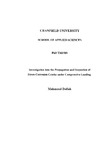JavaScript is disabled for your browser. Some features of this site may not work without it.
| dc.contributor.advisor | Robinson, M. J. | |
| dc.contributor.author | Dollah, Mahmood | |
| dc.date.accessioned | 2009-11-14T12:01:38Z | |
| dc.date.available | 2009-11-14T12:01:38Z | |
| dc.date.issued | 2007-07 | |
| dc.identifier.uri | http://hdl.handle.net/1826/3962 | |
| dc.description.abstract | Eddy current testing has become a widely used nondestructive technique for material testing and evaluation. This technique depends on the interaction between the impedance of the test coil and the material as the probe scans the surface of a material under investigation. By measuring the change in impedance of the test coil, the size of an imperfection in the material can be determined. In this project, the first aim of the research was to investigate and develop the use of the eddy current technique to detect stress corrosion cracks (SCC) in the bore of fastener holes. Specimens were scanned with the probe moving in and out the hole to produce a signal of the eddy current response. In addition, due to the skin depth effect, the operating frequency was also taken into consideration as an important parameter. A calibration standard test piece was prepared to represent SCC around a fastener hole, with the cracks lying in a plane parallel to the surface. Data from eddy current tests on real stress corrosion cracks has been used to develop an eddy current calibration curve for predicting stress corrosion crack lengths in larger components. The second aim of the project was to use the eddy current technique to study SCC crack growth in high strength aluminium alloy 7075-W under both tensile and compressive loading conditions. The importance of parameters such as heat treatment, grain shape, grain aspect ratio, component of stress, threshold stress intensity and microstructure were all taken into consideration. The SCC development was found to follow an intergranular path, which strongly depended on the microstructure of the material. Tests were carried out using double cantilever beam specimens to measure the threshold stress intensity, Kiscc, below which SCC would not occur. The specimens showed evidence of exfoliation corrosion at the surface and corrosion product wedging within the stress corrosion cracks, which caused further crack growth at the low applied stresses. Stress corrosion cracks were found to grow in 7075-W under high compressive loading, whereas control tests without compressive test stress produced only exfoliation corrosion and no crack growth. The mechanism of SCC in both tensile and compressive loading was thought to be anodic dissolution of metal at the crack tip, with protective films being disrupted by dislocation movement with the formation of active slip-steps. | en_UK |
| dc.language.iso | en | en_UK |
| dc.publisher | Cranfield University | en_UK |
| dc.title | Investigation into the propagation and inspection of stress corrosion cracks under compressive loading | en_UK |
| dc.type | Thesis or dissertation | en_UK |
| dc.type.qualificationlevel | Doctoral | en_UK |
| dc.type.qualificationname | PhD | en_UK |
